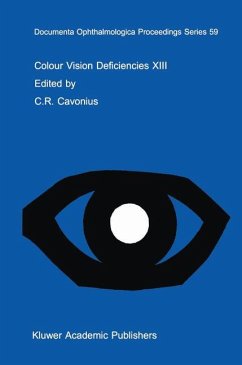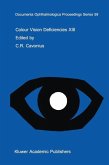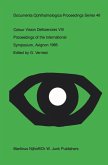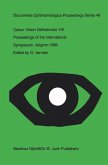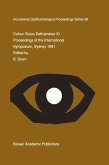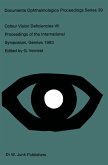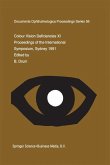Colour Vision Deficiencies XIII
Proceedings of the thirteenth Symposium of the International Research Group on Colour Vision Deficiencies, held in Pau, France July 27¿30, 1995
Herausgegeben:Cavonius, C. R.
Colour Vision Deficiencies XIII
Proceedings of the thirteenth Symposium of the International Research Group on Colour Vision Deficiencies, held in Pau, France July 27¿30, 1995
Herausgegeben:Cavonius, C. R.
- Broschiertes Buch
- Merkliste
- Auf die Merkliste
- Bewerten Bewerten
- Teilen
- Produkt teilen
- Produkterinnerung
- Produkterinnerung
The 13th biennial Symposium of the International Research Group on Colour Vision Deficiencies was held from 27 July to 30 July, 1995, in the splendidjin de siecle Theatre Saint Louis, in Pau, France. A total of 80 papers and posters were presented during the four days, of which 56 have been selected for inclusion in this volume. Each has been reviewed by two of the Editors. Additionally, in numerous cases in which specialized knowledge was called for the Editors asked for external help; their assistance is acknowledged below. While Pau now exists largely on agriculture and, more recently, oil…mehr
Andere Kunden interessierten sich auch für
![Colour Vision Deficiencies XIII Colour Vision Deficiencies XIII]() C.R. Cavonius (ed.)Colour Vision Deficiencies XIII166,99 €
C.R. Cavonius (ed.)Colour Vision Deficiencies XIII166,99 €![Colour Vision Deficiencies VIII Colour Vision Deficiencies VIII]() Colour Vision Deficiencies VIII249,99 €
Colour Vision Deficiencies VIII249,99 €![Colour Vision Deficiencies VIII Colour Vision Deficiencies VIII]() G. Verriest (Hrsg.)Colour Vision Deficiencies VIII249,99 €
G. Verriest (Hrsg.)Colour Vision Deficiencies VIII249,99 €![Colour Vision Deficiencies XI Colour Vision Deficiencies XI]() B. Drum (ed.)Colour Vision Deficiencies XI249,99 €
B. Drum (ed.)Colour Vision Deficiencies XI249,99 €![Colour Vision Deficiencies VII Colour Vision Deficiencies VII]() Colour Vision Deficiencies VII166,99 €
Colour Vision Deficiencies VII166,99 €![Colour Vision Deficiencies XI Colour Vision Deficiencies XI]() Colour Vision Deficiencies XI249,99 €
Colour Vision Deficiencies XI249,99 €![Colour Vision Deficiencies VII Colour Vision Deficiencies VII]() G. Verriest (Hrsg.)Colour Vision Deficiencies VII166,99 €
G. Verriest (Hrsg.)Colour Vision Deficiencies VII166,99 €-
-
-
The 13th biennial Symposium of the International Research Group on Colour Vision Deficiencies was held from 27 July to 30 July, 1995, in the splendidjin de siecle Theatre Saint Louis, in Pau, France. A total of 80 papers and posters were presented during the four days, of which 56 have been selected for inclusion in this volume. Each has been reviewed by two of the Editors. Additionally, in numerous cases in which specialized knowledge was called for the Editors asked for external help; their assistance is acknowledged below. While Pau now exists largely on agriculture and, more recently, oil extraction and refining, a century ago it was a winter resort that rivalled Cannes and Nice; indeed, Baedeker judged the air of Pau to be preferable for those of a nervous disposition. Pau and the surrounding Beam district are rich in history and have close ties to the Basque region, both of which were exploited brilliantly by the local organizers, Doctors Jean and Veronique Lied, to introduce the partici pants to the gastronomy and traditions of the region. The Committee of the IRGCVD owe a great debt of gratitude to the external reviewers, Oscar Estevez, Karl Gegenfurtner, Gunilla Haegerstrom-Portnoy, RL. Hilz, John Krauskopf, Anne Kurtenbach, Barry B. Lee, Adam Reeves, Marilyn Schneck, L.T. Sharpe, Eugene Switkes, Wayne Verdon, and B.A.
Produktdetails
- Produktdetails
- Documenta Ophthalmologica Proceedings Series 59
- Verlag: Springer / Springer Netherlands
- Artikelnr. des Verlages: 978-94-010-6275-6
- Softcover reprint of the original 1st ed. 1997
- Seitenzahl: 536
- Erscheinungstermin: 5. November 2012
- Englisch
- Abmessung: 240mm x 160mm x 29mm
- Gewicht: 847g
- ISBN-13: 9789401062756
- ISBN-10: 9401062757
- Artikelnr.: 37477388
- Herstellerkennzeichnung Die Herstellerinformationen sind derzeit nicht verfügbar.
- Documenta Ophthalmologica Proceedings Series 59
- Verlag: Springer / Springer Netherlands
- Artikelnr. des Verlages: 978-94-010-6275-6
- Softcover reprint of the original 1st ed. 1997
- Seitenzahl: 536
- Erscheinungstermin: 5. November 2012
- Englisch
- Abmessung: 240mm x 160mm x 29mm
- Gewicht: 847g
- ISBN-13: 9789401062756
- ISBN-10: 9401062757
- Artikelnr.: 37477388
- Herstellerkennzeichnung Die Herstellerinformationen sind derzeit nicht verfügbar.
1. '... aus dreyerley Arten von Membranen oder Molekülen': George Palmer's legacy.- 2. Levels of expression of the red, green and green-red hybrid pigment genes in the human retina.- 3. Variety of photopigment genes underlying red-green colour vision.- 4. Phenotypes of anomalous trichromacy.- 5. Ratio of M/L pigment gene expression decreases with retinal eccentricity.- 6. Unique hues in heterozygotes for protan and deutan deficiencies.- 7. Sensitivity and spectral tuning of the red-green chromatic pathway in heterozygous carriers of congenital colour vision defect.- 8. Rod and cone inputs to parvo- and magnocellular cells in the dichromatic common marmoset (Callithrix jacchus).- 9. Results of clinical colour vision tests of 'Pigmentfarbenanomale'.- 10. Seattle, WA, USA): Structure and function in primate retina.- 11. Four cone subtypes in a primitive mammal, the South American opossum - immunocytochemical characterization.- 12. Physical and sensory analysis of successive scotopic colour contrast.- 13. Visual colour processing is completed in the retina.- 14. Selective stimulation of colour vision in humans.- 15. Topographic differences of spectral sensitivity in rabbit retina. Evidence from small-field ERG and immunohistochemistry.- 16. Colour vision in a family with butterfly-shaped pigment dystrophy of the fovea.- 17. Colour vision deficiencies in two unrelated Sardinian families with butterfly-shaped macular dystrophy.- 18. Spatio-chromatic VEPs in recovered optic neuritis and multiple sclerosis.- 19. The effect of carbamazepine, phenytoin and valproic acid anti-epileptic convulsive drugs on visual perception.- 20. Colour vision in macular gliosis, cysts, holes and oedema: An approach to depth localization.- 21. A. Kurtenbach, U. Schiefer, E. Zrenner andA. Neu (Tübingen, Germany): Juvenile diabetics and the colour vision meter.- 22. Chromatic discrimination in subjects with both congenital and acquired colour vision deficiencies.- 23. Acquired tritanopia in diabetic maculopathy.- 24. A protocol for monitoring treatment with synthetic anti-malarial drugs.- 25. Visual function in patients affected by multiple sclerosis: visual field and colour vision.- 26. Features of foveal dichromacy illustrated by deuteranopia.- 27. The relative salience of the cardinal axes of colour space in normal and anomalous trichromats.- 28. Age-matched comparisons of chromatic thresholds between normal and strabismic observers.- 29. Detecting colour vision deficiency in 4- and 8-week-old human infants.- 30. Cone monochromacy: A case report.- 31. A new phenotype? Nagel 'dichromats' who reject 'red matches green' for a 2° field.- 32. Influence of stimulus luminance on automated Moreland matches.- 33. The clinical use of saturated and unsaturated Munsell panel tests.- 34. The pseudoisochromatic plates of E. N. Yustova.- 35. Evaluation of the desaturated Roth 28 HUE colour test - preliminary results.- 36. Evaluation of Yu's Chinese pseudoisochromatic plates for acquired dyschromatopsia.- 37. Screening colour vision with an LMS calibrated display.- 38. Coldef and tritan flicker test: PC-based evaluation of central and peripheral colour vision.- 39. Effect of macular pigment on colour matching with field sizes in the 1° to 10° range.- 40. Psychometric functions for chromatic discriminations.- 41. Psychometric functions in the central visual field.- 42. Sons and mothers: Classification of colour-deficient and heterozygous subjects by counterphase modulation photometry.- 43. Influence of lightness (Munsell value) on desaturated PanelD15.- 44. Temperature and Rayleigh matching on Moreland's anomaloscope.- 45. Effect of longitudinal chromatic aberration on photometric matches using a heterochromatic square-wave grating.- 46. Detecting blue-cone monochromats by electroretinography.- 47. Fast determination of the spectral modulation sensitivity function:a comparison between trichromats and deuteranopes.- 48. Colour discrimination in a monoptic and dichoptic task.- 49. Optimal step sizes for colour and luminance staircasing.- 50. Light scattered in the eye and its effect on the measurement of the colour constancy index.- 51. Do rod signals add with S cone signals in increment detection?.- 52. Distant colour induction on Fechner-Benham top.- 53. Influence of rod adaptation upon chromatic and achromatic cone-vision.- 54. Defective colour vision is a risk factor in driving.- 55. Doctors with inherited colour vision deficiency: their difficulties in clinical work.- 56. How much light reaches the retina?.- Author Index.
1. '... aus dreyerley Arten von Membranen oder Molekülen': George Palmer's legacy.- 2. Levels of expression of the red, green and green-red hybrid pigment genes in the human retina.- 3. Variety of photopigment genes underlying red-green colour vision.- 4. Phenotypes of anomalous trichromacy.- 5. Ratio of M/L pigment gene expression decreases with retinal eccentricity.- 6. Unique hues in heterozygotes for protan and deutan deficiencies.- 7. Sensitivity and spectral tuning of the red-green chromatic pathway in heterozygous carriers of congenital colour vision defect.- 8. Rod and cone inputs to parvo- and magnocellular cells in the dichromatic common marmoset (Callithrix jacchus).- 9. Results of clinical colour vision tests of 'Pigmentfarbenanomale'.- 10. Seattle, WA, USA): Structure and function in primate retina.- 11. Four cone subtypes in a primitive mammal, the South American opossum - immunocytochemical characterization.- 12. Physical and sensory analysis of successive scotopic colour contrast.- 13. Visual colour processing is completed in the retina.- 14. Selective stimulation of colour vision in humans.- 15. Topographic differences of spectral sensitivity in rabbit retina. Evidence from small-field ERG and immunohistochemistry.- 16. Colour vision in a family with butterfly-shaped pigment dystrophy of the fovea.- 17. Colour vision deficiencies in two unrelated Sardinian families with butterfly-shaped macular dystrophy.- 18. Spatio-chromatic VEPs in recovered optic neuritis and multiple sclerosis.- 19. The effect of carbamazepine, phenytoin and valproic acid anti-epileptic convulsive drugs on visual perception.- 20. Colour vision in macular gliosis, cysts, holes and oedema: An approach to depth localization.- 21. A. Kurtenbach, U. Schiefer, E. Zrenner andA. Neu (Tübingen, Germany): Juvenile diabetics and the colour vision meter.- 22. Chromatic discrimination in subjects with both congenital and acquired colour vision deficiencies.- 23. Acquired tritanopia in diabetic maculopathy.- 24. A protocol for monitoring treatment with synthetic anti-malarial drugs.- 25. Visual function in patients affected by multiple sclerosis: visual field and colour vision.- 26. Features of foveal dichromacy illustrated by deuteranopia.- 27. The relative salience of the cardinal axes of colour space in normal and anomalous trichromats.- 28. Age-matched comparisons of chromatic thresholds between normal and strabismic observers.- 29. Detecting colour vision deficiency in 4- and 8-week-old human infants.- 30. Cone monochromacy: A case report.- 31. A new phenotype? Nagel 'dichromats' who reject 'red matches green' for a 2° field.- 32. Influence of stimulus luminance on automated Moreland matches.- 33. The clinical use of saturated and unsaturated Munsell panel tests.- 34. The pseudoisochromatic plates of E. N. Yustova.- 35. Evaluation of the desaturated Roth 28 HUE colour test - preliminary results.- 36. Evaluation of Yu's Chinese pseudoisochromatic plates for acquired dyschromatopsia.- 37. Screening colour vision with an LMS calibrated display.- 38. Coldef and tritan flicker test: PC-based evaluation of central and peripheral colour vision.- 39. Effect of macular pigment on colour matching with field sizes in the 1° to 10° range.- 40. Psychometric functions for chromatic discriminations.- 41. Psychometric functions in the central visual field.- 42. Sons and mothers: Classification of colour-deficient and heterozygous subjects by counterphase modulation photometry.- 43. Influence of lightness (Munsell value) on desaturated PanelD15.- 44. Temperature and Rayleigh matching on Moreland's anomaloscope.- 45. Effect of longitudinal chromatic aberration on photometric matches using a heterochromatic square-wave grating.- 46. Detecting blue-cone monochromats by electroretinography.- 47. Fast determination of the spectral modulation sensitivity function:a comparison between trichromats and deuteranopes.- 48. Colour discrimination in a monoptic and dichoptic task.- 49. Optimal step sizes for colour and luminance staircasing.- 50. Light scattered in the eye and its effect on the measurement of the colour constancy index.- 51. Do rod signals add with S cone signals in increment detection?.- 52. Distant colour induction on Fechner-Benham top.- 53. Influence of rod adaptation upon chromatic and achromatic cone-vision.- 54. Defective colour vision is a risk factor in driving.- 55. Doctors with inherited colour vision deficiency: their difficulties in clinical work.- 56. How much light reaches the retina?.- Author Index.

